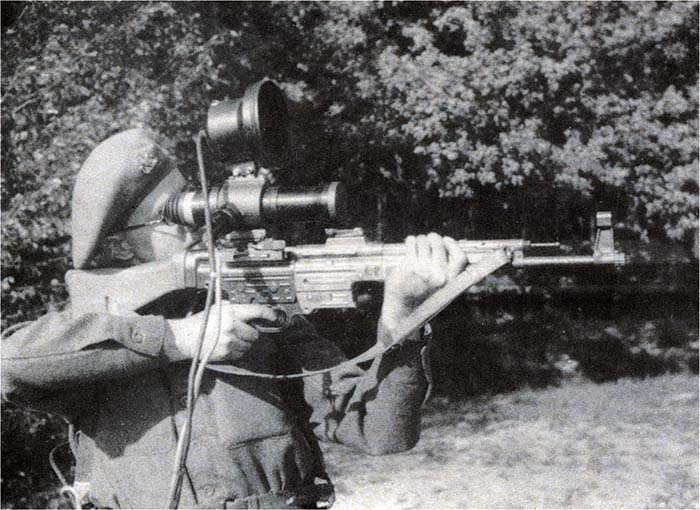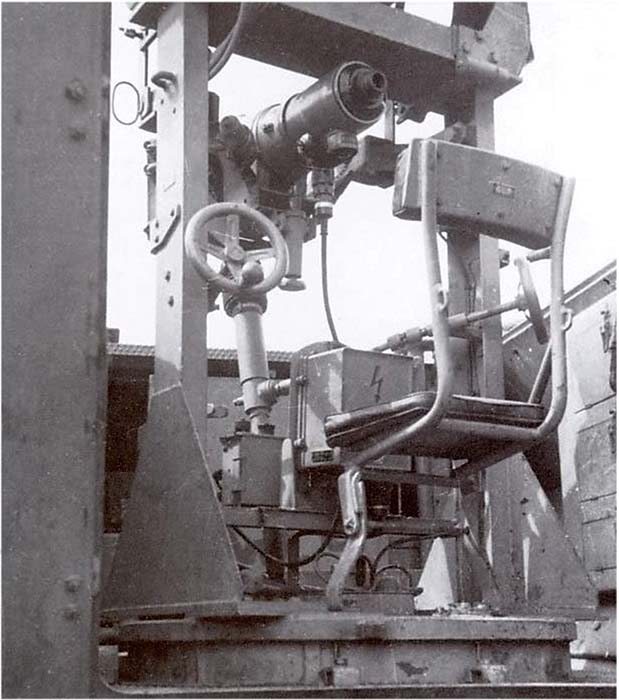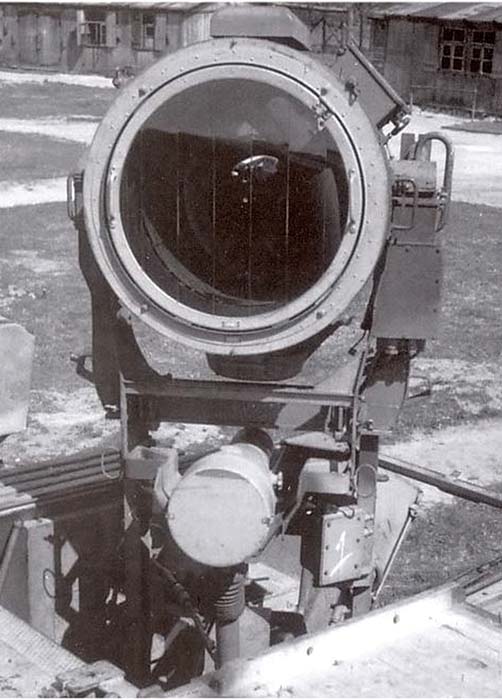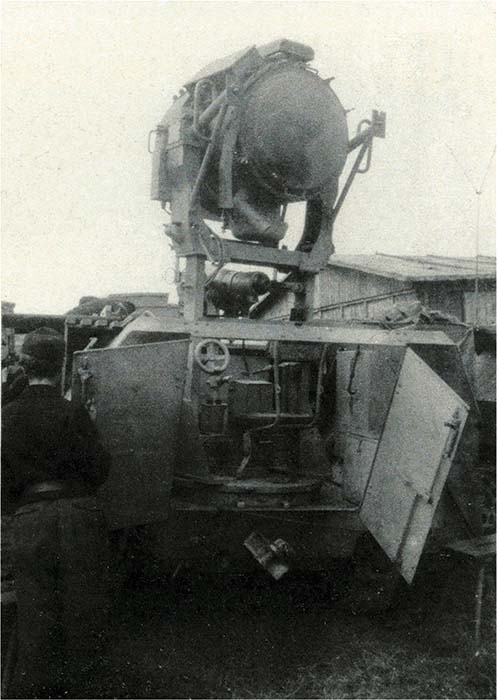The ZG 1229 Vampir was attached to the MP 44 by using the standard ZF-4 sniper scope rail. Note the heavy backpack.
By Michael Heidler
Germany began research on infra-red (I.R.) equipment in the early 1930s. The main development work was done by the well-known companies AEG (Allgemeine Elektricitäts-Gesellschaft) and Carl Zeiss. In 1942, a device named ZG 1221 was tested on a Pak 40 anti-tank gun. Because of the increasing air superiority of the Allies, the daytime travel of tank units became more and more dangerous so General Guderian suggested an I.R. sight modified for use on a Panther tank while travelling at night. Towards the end of the war the development was going on and field trials were still being done. Also, information and samples of all this equipment had been sent freely to the Japanese.
At the end of the war, the German battle group Kampfgruppe Uhu (eagle owl) consisting of some 260 officers and men was captured by British troops near the city of Fallingbostel in Lower Saxony. The equipment captured intact was held for examination by a troop of an A.A. Brigade. The battle group was a training unit and had not used their equipment in action. It was under the command of Major Graf von Werthen and Hauptmann Rietz.
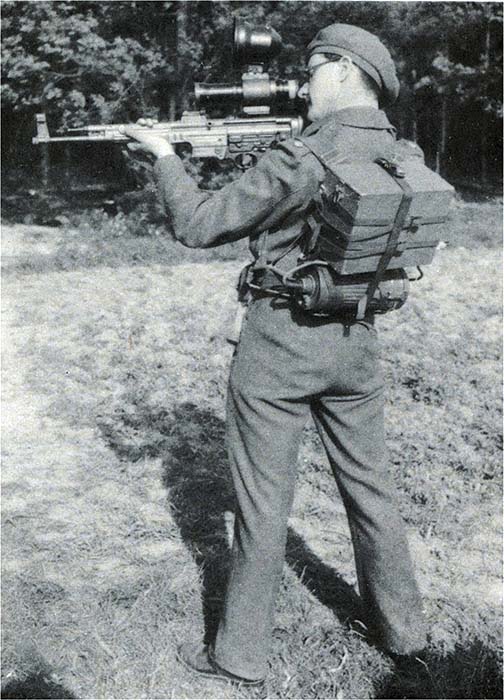
Vehicles fitted with I.R. gear were: 16 Falke, 4 Uhu, and 3 private cars (including 1 Volkswagen)
All the equipment was examined in detail by the team and the German officers were interrogated throughout the day on May 14, 1945. That night a working demonstration was given, under very clear weather conditions and the moon was very low. A few days later Major Graf von Werthen and Hauptmann Rietz were sent to England. Also all Vampir devices together with one MP 44 assault rifle, two Falke (including vehicles), one Uhu, one ZG 1221 and one pair of binoculars were shipped to the ARI (Army Research Institute). The rest of the equipment was handed over to the Americans.
The undermentioned pieces of equipment all consisted basically of transmitter and receiver. The former was a source of light screened to transmit only I.R. radiation. The latter comprised an image converter to form a visible image of the I.R. picture. The several pieces of equipment differed fundamentally only in size. Different code names or numbers were employed according to the size of the gear; the application to which it was put, or the vehicle to which it was fitted. The image converters are of the cesium electronic focusing type, operating from a high tension source.
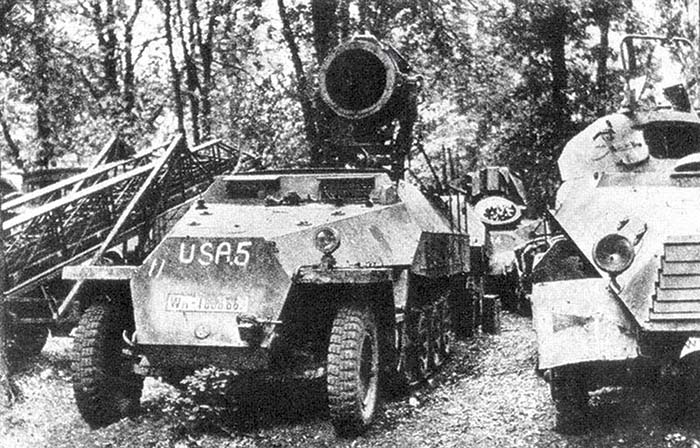
The demonstration was given on the training ground at Fallingbostel previously used by the German unit. For the demonstration of Vampir, the ground was uneven, and covered by coarse grass and birch shrubs. For all other devices the ground consisted of a very open stretch of sandy ground, clear of vegetation for at least 1,000 yards, and free of “dead ground.” The sand was grey, streaked with lighter patches.
The following part is a slightly corrected excerpt of the report written on June 4, 1945:
ZG 1229 Vampir (ZG = Zielgerät / aiming device). This is a man-borne equipment intended for use with the MP 44 assault rifle (Sturmgewehr). The transmitter is a 35 watt lamp of diameter about 5 inches and the receiver a telescope of unit magnification about 14 inches long and 2.5 inches diameter. The two together weigh about 5 pounds and are mounted on the assault rifle. Power for transmitter and receiver is drawn from a power unit carried in a pack. This power unit weighs about 30 pounds and has a life on one charge of 3 to 5 hours. The high tension unit for the receiver produces 11 kilovolts.
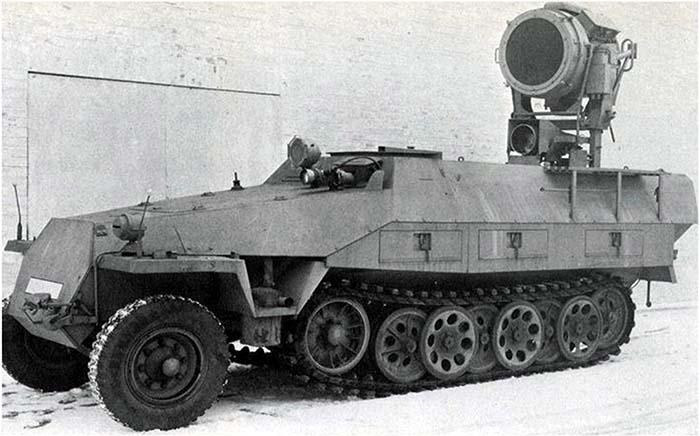
The immediate impression in the demonstration was of great brilliance and good contrast in the picture. British and German troops were used as targets with the following results:
The equipment was said to have been used operationally with very good results. The particular use to which it had been put was for protecting vehicles from infantry attack at night. Two men equipped with Vampir were stationed on the rear of the vehicle for this purpose. It was considered by the investigators that the special gear had been fitted to a weapon which was too heavy for protracted use.
FG 1250 (FG = Fahrgerät / driving device). This is equipment analogous to Vampir, but larger in scale fitted to an MG 42 gun carried on a Sd.Kfz. 251/20 half-track vehicle. The transmitter is a 200 watt lamp, resembling a large motor car headlamp, of diameter 8 inches. The receiver is a telescope of length 20 inches and diameter 5 inches. Power is supplied from a power pack operated from the vehicle battery.
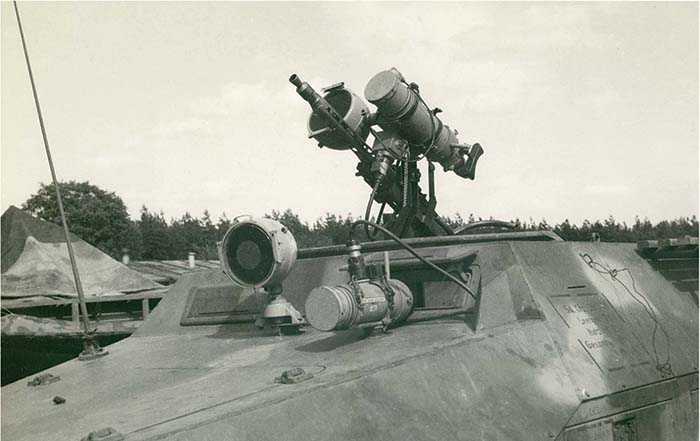
Alternative methods of presentation are available. In the arrangement most frequently used, unit magnification is obtained with large viewing lens which enables both eyes to be used. An auxiliary lens can be inserted to give enlarged, monocular vision. A reticule is fitted for aiming. Men standing were clearly discernible at 400 yards. The beam width appeared to be adequate.
FG 1252. This is the transmitter and receiver only of FG 1250 intended for night driving. For this purpose a 100 watt lamp is used in the same lantern, and a diffusing glass is fitted to give a wide beam. An early form of this equipment was termed Spanner. The equipment was seen in action on a Volkswagen. Compared with the British E equipment the picture was of greater brilliance and contrast, but the lack of stereoscopic vision and the distortion at the edges of the picture made its use difficult over rough terrain. The German drivers were, however, able to maintain a high speed on roads where progress was as fast as with normal headlamps.
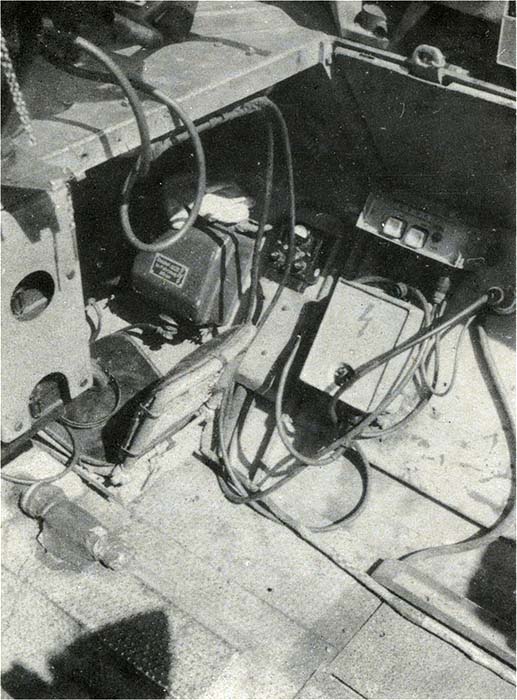
Falke (falcon). This term is applied to the Sd.Kfz. 251/20 vehicle equipped with both FG 1250 and FG 1252.
Puma. This term is applied to the Panther tank equipped with FG 1250.
Sperber (sparrowhawk). This term is applied to the Panther tank equipped with both FG 1250 and FG 1252.
Uhu (eagle owl). This is the largest German Army service equipment, consisting of a screened 60 cm searchlight as transmitter and a telescope giving 10 times magnification, of length about 24 inches and diameter about 10 inches, as receiver. The receiver has an objective of 40 cm focus and relative aperture f/1.4. The latter instrument may well be a pre-production form of the Uhu receiver. The equipment is mounted on an unarmed Sd.Kfz. 251/20 vehicle which also carries an 8 kilowatt generator for the searchlight. The vehicle is intended for reconnaissance purposes and to illuminate targets that could be engaged by Puma. The searchlight has a beam width of approximately 3°, and consumes 5½ kilowatts. Two filters are used.
The searchlight and receiver are mounted in permanent alignment, on a mounting which includes the observer’s chair, and which can be traversed through 360°. An arrangement for altering the elevation is also provided.
A half-track vehicle was used as target, at a range of 1,000 yards, and the apparatus was trained on the vehicle by the German crew. On observing through the telescope, the investigators questioned the accuracy of adjustment, as the target was indistinct. The adjustment was confirmed by a member of the crew, but it was subsequently found that the beam had not in fact been trained on the vehicle, but on some other object. The vehicle, when properly illuminated, was well seen by one of the team. These circumstances are reported in some detail since they illustrate a feature of Uhu which had already been noticed, namely that the beam is narrow.
Uhu and Puma in combination were said to have been used by two units on the Eastern Front with immense success; it was claimed that 67 Russian tanks had been knocked out in one night. These two units and the unit captured were said to be the only three German units equipped with I.R. gear. Gear for other units was, however, said to be in existence hidden in various places, which are known to Major Graf von Werthen.
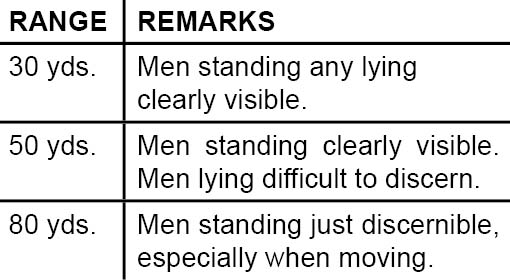
ZG 1221. This is a 36 cm searchlight which has been produced only on an experimental scale. Its performance was not assessed.
Binoculars. This is a pocket receiver, without transmitter, developed experimentally. It is the smallest equipment available. One half of the instrument is a night glass, the other half an I.R. receiver. Its performance was not assessed.
Major Graf von Werthen was asked to state the extent to which the equipment had been used in operations. He indicated that it had been used by small groups on the Eastern Front, but that full reports were lacking. When asked why the equipment had not been used on the Western Front, he stated that this policy had been laid down by Guderian, but was unable to explain the reason for it. One reason could have been the fact that the Germans knew that the British had an infra-red receiver of compact and simple design, which could have been used for detection of searchlights.
Nevertheless, when used in action, the units equipped with I.R. gear often achieved successes. Some Panther tanks of the Panzerdivision Clausewitz are told to have overrun an American anti-tank position on the Weser-Elbe Canal on April 21, 1945. Also the Panzer-Division Müncheberg successfully used I.R. gear for repelling Russian night attacks during the intense Battle of the Seelow Heights east of Berlin. Unfortunately, not much official paperwork is left today and most of the reports written down after the war can’t be confirmed and are questionable.
(Thanks to Gregory Hagge, U.S. Army Ordnance Training & Heritage Centre, Fort Lee, Virginia/USA)
| This article first appeared in Small Arms Review V19N5 (June 2015) |



